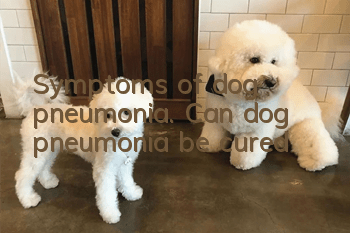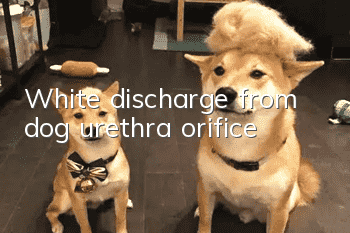Symptoms of dog pneumonia. Can dog pneumonia be cured?

What is pneumonia
Pneumonia is a serious disease involving inflammation of the lungs and lower respiratory tract. It also usually affects the upper respiratory tract - the nose, throat, trachea ("trachea") and bronchi. The lungs supply the blood with oxygen from the inhaled air and remove carbon dioxide from the exhaled air. Pneumonia can be caused by bacteria, viruses, fungi, internal parasites, and other harmful substances that can enter the lungs when dogs inhale them. Fortunately, pneumonia is relatively rare in healthy adult dogs (young and middle-aged dogs). It mainly affects very young dogs, very old dogs and dogs with low immunity. Some dogs with pneumonia have no symptoms, but some dogs have shortness of breath and difficulty breathing due to insufficient oxygen in the blood. Symptoms include runny nose, coughing, sneezing, fever, loss of appetite, becoming weak, depressed, and listless.
Causes of Pneumonia
Pneumonia can be caused by a variety of factors, including viruses, bacteria, fungi, and internal parasites. Before people and dogs develop pneumonia, other parts of the nasal cavity and upper respiratory tract send out early signs of infection. Pneumonia in adult dogs is always associated with chemotherapy drugs, chronic systemic disease, laryngeal paralysis, gastroesophageal reflux disease, respiratory tract tumors, giant esophageal tumors, malnutrition, stress, tumors, parasitic infections, inhaled foreign bodies, chronic bronchitis (bronchitis) inflammation), esophagitis (inflammation of the esophagus), tracheal collapse, pyloric output obstruction, or long-term drug treatment.
Most bacterial pneumonias are caused by bacteria in the mouth (mouth) and pharynx (throat) that enter the lungs through the upper respiratory tract and colonize certain areas of the lungs through gravity. Pneumonia caused by bacteria that reach the lungs through the blood supply (hemopoiesis) usually spreads more widely throughout the lobes. Suspected bacterial organisms include E. coli, Klebsiella, Proteus, Streptococcus, Staphylococcus, Burnetii, and Pasteurella, among others. Bacterial pneumonia often develops secondary to viral pneumonia as the dog's immune system weakens.
Two of the more common viral pneumonias are canine distemper virus and canine influenza virus. Canine adenovirus type 1 and parainfluenza viruses can also infect the lower respiratory tract, and signs of pneumonia associated with these viruses are usually caused by secondary bacterial infection.
Aspiration pneumonia can be caused by any disease that negatively affects a dog's respiratory defense system or increases the risk of aspiration, including disease of the pharynx, larynx, esophagus, stomach, or intestines. Laryngeal paralysis, gastroesophageal reflux disease, megaesophagus, tumors, paralysis of complex swallowing mechanisms, esophagitis, pyloric output obstruction and trauma, as well as vomiting, reflux, or general anesthesia-induced reflux of gastric contents into the lungs, are Risk factors for aspiration pneumonia. It can also be precipitated by inhalation of smoke, mineral oil, kerosene, gasoline or other corrosive chemicals. Diseases that cause altered consciousness or a chronic vomiting state can also predispose dogs to aspiration pneumonia.
PreventionPneumonia
One of the key ways to prevent pneumonia is to address any predisposing conditions, such as gastric reflux disorder, laryngeal paralysis, or pyloric outlet obstruction. Other important recommendations are to prevent vomiting and aspiration of gastric contents and to fast for 12 hours before general anesthesia (antacids can appropriately reduce gastric reflux in dogs). Feed only when the dog's health requires it, and even then, use caution.
tip: Dogs with severe respiratory distress should not take cough medicine, because coughing is a normal reaction of the body, and coughing to clear the respiratory tract can help the dog breathe.
Initial diagnosis
When a dog is in respiratory distress, the veterinarian will take all necessary measures to ensure that the patient is breathing normally. Once normal, the dog will be given a comprehensive physical examination and the owner will be consulted about the daily routine. symptom. Initial workup includes routine blood work (complete blood count [CBC] and serum chemistry panel) and urinalysis. The results of these preliminary tests may or may not be normal. Even if it is normal, pneumonia cannot be ruled out.
Diagnosis process
The diagnostic step is to take chest X-rays (chest X-rays) from several different angles. Chest X-rays can diagnose the presence of pneumonia. But the cause of a specific lung infection is usually to collect, examine and culture a blood sample. In-depth blood testing should identify the specific microorganisms involved, allowing the veterinarian to choose the most appropriate antibacterial, antiviral, antifungal, antiparasitic, or other treatment regimen.
Another common diagnostic tool is endotracheal lavage. This is a respiratory scrubbing procedure that involves flushing the airways with a sterile solution, aspirating fluid and moving airway cells back into a syringe, and submitting the sample to a diagnostic laboratory for evaluation and culture. Arterial blood gas analysis and pulse oximetry can be used to assess the amount of oxygen in the blood (this is called oxygenation). Bronchoscopy is a technique in which the veterinarian inserts a wand-like instrument with its tip down the trachea and into the upper bronchi, allowing her to see the lining of the airway and remove any accessible foreign matter that may be blocking the upper airway. Tumors can also be discovered and biopsied using this technique. Computed tomography (CT scan) is available in some specialized clinics but is usually not required.
Dangers of pneumonia
Pneumonia is relatively rare in healthy adult dogs (young and middle-aged dogs). Mainly affecting very young dogs, very old dogs and dogs with compromised immune systems, pneumonia is divided into acute and chronic forms. The main functions of the lungs are to draw oxygen from the blood from outside air and to process carbon dioxide waste in the exhaled air. When signs of pneumonia appear, they are due to a lack of oxygen and inefficient oxygen exchange and delivery to body cells, both caused by inflammation and irritation of the airways and lung tissue and the accumulation of mucus in the respiratory tract.
Symptoms of pneumonia in dogs are as follows:
A dog with pneumonia may never show signs ofshowing signs of illness. When symptoms occur, they can include one or more of the following:
1. Tachypnea (increased breathing rate; shortness of breath)
2. Take a deep breath (increase breathing depth)
3. Difficulty breathing
4. Cough (dry cough, cough with saliva, cough with bubbles)
5. Nasal discharge (usually from both nostrils), thick mucus and pus.
6. Sneezing
7. Chest congestion (wheezing and crackling sounds heard during auscultation [listening through a stethoscope])
8. Fever
9. Loss of appetite
10. Weight loss
11. Rapid heart rate
12. Abnormal standing posture (head lowered, front legs spread at the elbow)
13.Depression
14. Drowsiness
15. Movement disorders
17. Weakness
16. Blue discoloration of skin and mucous membranes
Prognosis
The prognosis of dogs with pneumonia depends on the cause and severity of the dog. Dogs without complicated pneumonia generally have a good prognosis. Most bacterial pneumonias can be treated successfully. Acute onset aspiration pneumonia with severe respiratory distress can be fatal. If the underlying cause of pneumonia is not discovered and corrected, the disease is likely to recur.- What to do if your dog has double rows of teeth
- Things to note when feeding Teddy dogs
- Signs your dog loves you
- Common dog diseases in winter
- What are the symptoms of rabies in dogs?
- What are the symptoms of false pregnancy in dogs?
- Letting your dog walk upright is very harmful. Don’t let your ignorant interest ruin your dog’s life!
- What should I do if my dog has fleas? How to get rid of fleas on your dog?
- Why should a dog’s tail be docked? What are the reasons for docking a dog’s tail?
- What causes tear stains in dogs and how to improve them



